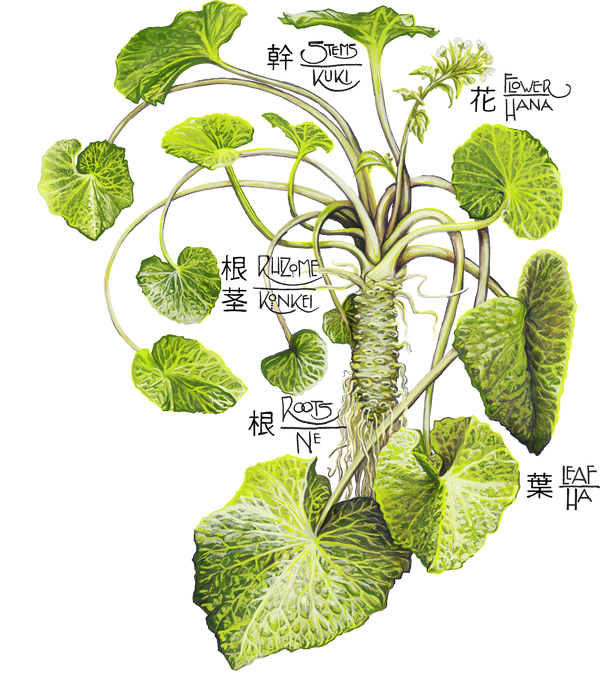
Which Oroshiki?
Share
First, let me explain what an oroshiki is. Often called oroshi or oroshigane, oroshiki simply translates to 'grater.' The Japanese have been crafting different types of oroshi for different types of fruit, fish and vegetables for thousands of years. For the majority of that time, the materials used have changed little. But modern times call for cooler things. And current trends can change the rules.
One of these specialized grating tools created in the late Edo period was the wasabi oroshigane. This tool, made from the belly of a reef shark species caught in shallow coastal waters, was designed to maximize wasabi flavors. Those flavors being pungency, sweetness, and wasabi earthy umami. Wasabi is sort of a magic trick, and the secret lies in cellular disruption. The finer you grind, the more you damage and grate down the fibers of the wasabi meristem. The creamier the paste, the more pungent and sweet compounds you potentiate.
Traditional Shark Skin - Long before fish had rights, Edo period oroshigane craftsmen scoured the docks for angel shark caracasses. This low swimming and sand dwelling reef shark's belly had the perfect grooves, bristles, and friction for grating wasabi. The skins of the shark were removed, the belly portion cut separately, dried, then glued and hammered to hinoki or sugi cedar paddles specially carved to fit the hand dimensions of chefs. As time and man progressed, so did laws. Angel shark was no longer able to be used starting in the mid 1980's. An alternative was needed. Today, a species of ray fish sourced from South East Asia is used. Although not as efficient and durable as angel shark, it's a win-win as what was once a discarded by-product is now put to use for a product that was going the way of the dinosaur.
The benefits of shark skin are it's a natural surface, so no micro-metals or synthetics will grate off into your wasabi. Traditional shark skin graters go through wasabi quicker, and create a thicker, and slightly chunkier paste. The result is a cream that is not as pungent or sweet as newer, stainless steel oroshiki, but it's plenty for what you need. These are excellent tools that grate to a high standard and create a supreme paste. A shark skin oroshoki should last you 3-500 grinds.
Hagane Zame - Stainless Steel Shark - Hagane zame translates to "Steel Shark,' with this oroshiki being the stainless steel counterpart to traditional shark skin graters. Produced by the Kinjirushi company and Designed by Yamamoto Yutaka, the surface of this grater spells wasabi in hiragana (わさび) over-and-over. Yutaka-San went through over 300 different test patterns before concluding that "WASABI" created the best cream in terms of isothiocyanate and glucose content.
I personally love the Hagane Zame. It's lightweight yet sturdy, grinds wasabi fairly quickly, and creates a much sweeter cream. I don't know if that's true of all wasabi, but our misho wasabi seems tend to be a bit more pungent and WAY sweeter when using the hagane zame. Very easy to clean. Long grind life. You will develop an oxidized circle in the center of your hagane zame over time.
Oni Namida - Oni Namida translates to "Demon Tears." The reference being this grater will create a cream so damn good and pungent it'll make a demon cry. I don't know if anyone in North America has this grater yet outside of myself and a couple of my friends, but this oroshigane is the top of the pyramid. The end all, be all. There are specially designed micro-teeth at alternating heights and at different angles that gets the wasabi to a level I've never seen. It's hard to describe, but when you touch it, it feels like magnetic sandpaper.
The Oni Namida takes longer to grind wasabi. I'd say about 25-30% longer to grate your desired amount. The trade-off is taste. This thing makes wasabi that is scarily pungent, and beautifully sweet, with a texture that I've seen actually bubble on occasion. There is no better wasabi grater out there. Period. Super durable. High quality construction. It's pretty heavy and can be a bit much to clean (do not use a sponge).
Metal Ginger Grater - Ginger graters are great, for ginger. Not so much for wasabi. They don't grate at a fine enough consistency to do an adequate job. You get a very chunky and lumpy cream. I have seen sushi chefs actually file down ginger graters for better results. Ginger graters are in the middle of the road. Better than nothing, but not great.
Porcelain Ginger Grater - These graters are pretty much the bottom of what I would accept as a tool to grate wasabi. Better than cheese graters, microplanes, food processors, or their equivalents, but you will be getting about 30-40% of the total potential of your plant. Use this grater only in emergency because you forgot to order one from me.
